|
Contents
HB 1079 Preliminary Corridor Analysis
The second round of Segment Committee meetings held the first week in February moved to presentations on Forecasted Conditions and Preliminary Corridor Analysis. In each segment both presentations provided positive data about the future of West and South Texas, the region served in Texas by the Ports-to-Plains Corridor. For the most part this data and modeling looked at the comparison between current demographic and economic data and the year 2050 with no improvements to the corridor or completing the four-lane divided Ports-to-Plains Corridor across Texas. In a few areas, the Segment Committees heard about the effect of improving the entire Ports-to-Plains Corridor in Texas to an Interstate Highway. The next round of Segment Committee Meetings in early April will look at additional results regarding the effect of upgrading the corridor to an Interstate Highway.
Here are some corridor-wide impacts for Texas that were presented to the Segment Committees:
- Four-Lane Divided growth in traffic is very similar to No Build. Improving the entire Ports-to-Plains Corridor to Four-lane Divided does not attract more traffic to the corridor and urban mobility and reliability are still an issue
- Development of the entire corridor to an Interstate Highway projects a 100-200% growth by 2050 over 2018 volumes found in all three segments
- In terms of mobility, comparing current Average Travel Time versus 75 mph Travel Time, users travelling the entire corridor would save 213 minutes (about 3½ hours)
- There would be 25 to 40% fewer crashes if the remaining two-lanes portions of the corridor were improved to Four-Lane Divided, but improvement to Interstate Highway results in an additional 15 to 25% fewer crashes
- Upgrade to Four-Lane Divided Highway has no material effect on truck tons above the 2050 forecast, but upgrade to Interstate Highway adds another 125% in diverted truck tons above the 2050 forecast
For a more complete look at these results, with the specifics from each segment, download the Summary Report by Clicking Here.
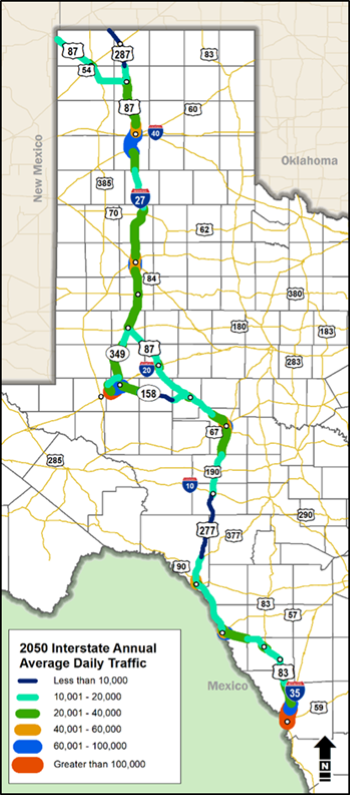
Return to Contents
NDDOT Launches Project to Expand U.S. 85 from Watford City to Long X Bridge on the Theodore Roosevelt Expressway
The North Dakota Department of Transportation (NDDOT) is expanding U.S. Highway 85 to a four-lane highway from Watford City to the Long X Bridge over the Little Missouri River. NDDOT is launching this highway widening project by starting project design, right-of-way acquisitions and utility relocation along the corridor.
The 11-mile, roughly $104 million, expansion project is the second phase of a multi-phase plan to four-lane the corridor.
“Highway 85 is a critical route for transportation and commerce in western North Dakota, yet it continues to see a high number of traffic crashes,” Gov. Doug Burgum said. “This expansion project will improve the flow of traffic for the public, business and industry and enhance safety as we work toward Vision Zero in our state.”
“On a project of this magnitude we work in collaboration with many stakeholders to make sure we are serving the needs of everyone impacted,” said NDDOT Director Bill Panos. “Our collaborative approach also benefits the project itself and gives us a better result for the impacted communities, businesses and the State of North Dakota.”
Click Here to Download Complete NDDOT News Release
Return to Contents
Heartland Expressway likely to see some expansion during 2021
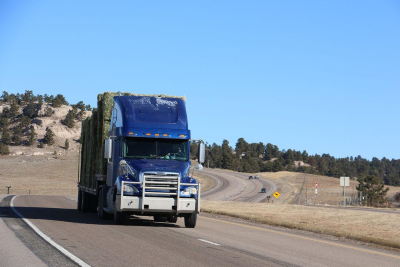
Deb Cottier, whose regular job is with Dawes County’s Northwest Nebraska Development Corporation, told the Western Nebraska Economic Development group Thursday that the expressway is expected to see some expansion likely in 2021. Bids will be let in August for an extended section of four-lane road on U.S. Highway 385 south of Alliance to the L62A junction, commonly referred to as the “Bayard turnoff.”
The next section to be addressed would be an 18-mile section of L62A from Minatare to the junction sometime after 2023. That project would use federal funds for the $60 million project.
Link to Complete Article in Scottsbluff Star-Herald
Return to Contents
New Mexico State Legislature Considering Support for Future Interstate
The New Mexico State Legislature began its consideration of House Memorial 49 with a hearing in the House Transportation, Public Works and Capital Improvements Committee. The Committee recommendation was a unanimous DO PASS. Thanks to State Representative Jack Chatfield for sponsoring this memorial, The title of the House Memorial 49 is: Requesting that United States Highways 64 and 87 from Raton to Clayton to the New Mexico-Texas State Line, a Portion of the Ports-to-Plains Corridor on the National Highway System, Be Designated as a Future Federal Interstate Highway.
A date has not been set for consideration on the floor of the New Mexico House of Representatives.
Return to Contents
Ports-to-Plains Alliance and Heartland Expressway Association Comments on R.O.U.T.E.S.
The U.S. Department of Transportation is requesting information related to the Rural Opportunities to Use Transportation for Economic Success (ROUTES) initiative. This initiative seeks to improve USDOT’s work and coordination across modes on rural infrastructure, and help rural infrastructure project sponsors better understand what grants are available to them.
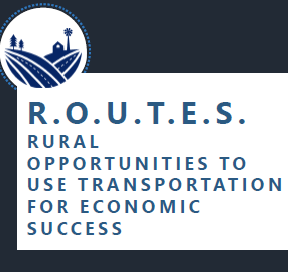
The Alliance made the following recommendations:
- Prioritize multi-state rural corridors on the National Highway System. The National Highway System are the highways of highest Federal interest, carrying over 55% of vehicle miles traveled and over 90% of truck vehicle miles traveled. Modernizing rural multi-state corridors on the NHS to safe, four-lane divided highways—even Interstate Highways where appropriate—should be a priority.
- Emphasize Connectivity. Connectivity should be a significant factor in DOT’s policies and decision-making. Multi-state rural corridors on the NHS—like the Ports-to-Plains Alliance Corridor—connect urban areas to each other; connect rural towns and communities to urban areas; connect urban and rural areas to the national and global economies; connect our national transportation network to international networks in Canada and Mexico; and connect all of America to the food, fuel, and fiber that secure our quality of life. Connectivity should be a priority.
- Provide Federal Leadership. The Ports-to-Plains Alliance Corridor runs through nine states. Modernizing multi-state corridors requires the coordinated and sustained efforts of all of the involved states. The benefits to the national transportation system and to America as a whole far outweigh the benefits to any particular state or area. For that reason, Federal leadership in modernizing multi-state corridors is essential and should be reflected in DOT policies and decision-making.
- Recognize That Rural America Is Different From Urban America. What works in Urban America does not always work in Rural America. Federal policies and decision-making should take that into account. For example, public private partnerships and other types of investment that rely on a dedicated revenue stream from the project are not an option for most projects in Rural America. Federal policies and decision-making should not put Rural America at a disadvantage by explicitly or implicitly requiring or leveraging use of PPPs or similar financing in order to qualify for assistance. Rural projects, especially development of rural multi-state corridors, require other forms of support, primarily grants.
- Overemphasis On High Volumes. DOT should not implement a one-size-fits-all approach to solving transportation challenges based on urban, high-congestion solutions. For example, an overemphasis on traffic counts and freight volume disadvantages Rural America, especially multi-state rural corridors, which often have much lower traffic counts and freight volumes. Providing connectivity to rural towns and communities, providing access to food, fuel and fiber resources, connecting Rural America to the national and international economies, and reducing fatalities and injuries on rural highways are all important policy objectives. An approach that recognizes and prioritizes the needs of Rural America is essential.
- Large Rural States in the West Present Special Problems. The Ports-to-Plains Alliance Corridor runs through nine rural states in the West. These states are geographically large, with extensive Federal lands and low population density. The West comprises 61% of the Nation’s land area, but has only 39% of Interstate Highway centerline miles. As a result, Interstates are further apart in the West, meaning that NAFTA traffic to and from Mexico in the West is not travelling on Interstate Highways. (See Remarks by Carlos Braceras, Utah DOT, Future Interstate Study Panel, Washington, DC, February 23, 2017). The Transportation Research Board has recommended in its recent report on the Interstate Highway System that DOT develop criteria for rightsizing the Interstate that would, among other things, address current and emerging demands to extend the Interstate Highway System’s length and scope of coverage. The Alliance strongly supports this effort and believes the Ports-to-Plains Alliance Corridor would be a strong candidate for inclusion in a rightsized Interstate.
- Cost-Effective Solutions for Congested Corridors. Modernizing rural multi-state corridors can be a cost-effective solution to relieving congestion on heavily congested NHS corridors. A good example is the Ports-to-Plains Alliance Corridor, which can be a cost-effective way to reduce congestion on gridlocked I-25 to the west and I-35 to the east. Upgrading the corridor to a modern four-lane, divided facility (even an Interstate Highway where appropriate) would cost a small fraction of the cost of improvements to I-25 and I-35. Once upgraded, a significant number of trucks are likely to divert to the Ports-to-Plains Corridor rather than sitting in congestion on I-25 or I-35, thereby providing congestion relief on these routes. Improved on-time delivery and decreased transportation costs for goods and services will be the result. Federal policies and decision-making should be flexible and consider these types of solutions.
- Increased Investment. Study after study, report after report, and commission after commission have recognized the need for increased investment in surface transportation. There is a need for increased investment in Rural America. There is a need for increased in investment in Urban America. DOT should take the lead in advocating for increased investment in our national transportation system. It should ensure Rural America is treated fairly in the distribution of funds. It should prioritize network investments. Modernizing the NHS, which includes the Interstate System, should be a focus of Federal policies and decision-making.
Both the Ports-to-Plains Alliance and its partner organization, the Heartland Expressway Association submitted comments.
Comments of the Ports-to-Plains Alliance
Comments of the Heartland Expressway Association
Return to Contents
Comments by Others on ROUTES
USDOT received 173 Comments on the Rural Opportunities to Use Transportation for Economic Success (R.O.U.T.E.S) Initiative. Below are some data points from other organizations within the Ports-to-Plains region which address rural transportation importance from those comments.

“TxDOT has identified more than $3 billion dollars in rural transportation investments needed on rural roadways through 2035. Texas has the largest combined non-urban (rural) and small urban area population in the country with 8.6 million people. Texas is the leading state in the number of rural miles of Interstate highways, U.S. highways, state highways and farm-to-market roads with over 56,000 miles. These roadways are economic engines, allowing everyone from farmers to manufacturers to move their goods to market. However, in recent years, increased oilfield development has had a significant impact on the condition of the rural system in some parts of Texas.” -- Texas Department of Transportation
“In Wyoming, for example, about 90 percent of the trucks on Interstate 80 have origins AND destinations beyond Wyoming’s borders. This is clearly national transportation and warrants Federal investment.”
“In addition, the Federal-aid highways in rural States:
- serve the nation’s agriculture and energy production industries, including ethanol and wind power, which are located largely in rural areas;
- provide access to scenic wonders like Yellowstone National Park, Mount Rushmore, and many other great national parks, monuments, and forests located in rural States;
- have become increasingly important to rural America, with the abandonment of many rail branch lines;
- are a lifeline for remotely located and economically challenged citizens, such as those living on tribal reservations;
- enable people and business to access and traverse vast tracts of Federally owned land; and
- facilitate military readiness.”
“For example, in 2017, North Dakota lead the nation in the production of many crops, including dry edible beans, canola, flaxseed, honey, peas, durum wheat, and spring wheat. Montana is a leading producer of wheat, peas, and other crops and in 2016 exported 80 percent of its nearly $1 billion wheat crop. South Dakota and Idaho are also major grain producers and possibly billions of people around the world have consumed Idaho potatoes. Wyoming produces significant grain and cattle consumed domestically and exported throughout the world. The highway network is essential to moving these important products to national and world markets and improving the U.S. economy.”
“So, we have very few people to support each lane mile of Federal-aid highway even as preserving this aging, nationally connected system is expensive. Yet, citizens from our States contribute to this effort significantly. Nationally, the per capita contribution to the Highway Account of the Highway Trust fund is approximately $117. The per capita contribution to the Highway Account attributable to rural States is much higher. In Wyoming it is the highest of the States at $312 annually per capita to the Highway Account; North Dakota, South Dakota, and Montana are the next highest.”-- Transportation Departments of Idaho, Montana, North Dakota, South Dakota, and Wyoming
“More than half the traffic on 1-80 consists of large trucks with heavy loads-at least 80 percent of which pass through without originating or terminating in the state-which reduce the longevity of pavement and structures and jeopardize the reliability and efficiency of the interstate for all travelers.”-- Wyoming Department of Transportation
“Travel loads on America’s rural roads are increasing, due partly to the booming energy extraction sector. This has been driven by increases in domestic oil and gas extraction, largely as a result of advancements in hydraulic fracturing (fracking), which has greatly increased the accessibility of shale oil and gas deposits, and the increased production of renewable energy such as wind and solar. This increased energy production activity has had significant impact on pavement and bridge conditions in those areas where energy production is concentrated.”
“Rural highways are an important link in supporting agriculture. Rural areas are home to the vast majority of the nation’s 2.2 million farms. Transportation is becoming an even more critical segment of the food distribution network. While food demand is concentrated mostly in urban areas, food distribution is the most dispersed segment of the economy. A safe and efficient transportation system can lead to lower food costs for U.S. consumers and higher market prices for producers due to lower shipping costs, smaller margins, and more competitive export prices. However, inadequate investment in transportation infrastructure can threaten the competitive advantage that U.S. agriculture industry currently enjoys.”-- Associated General Contractors of America (AGC)
“In Texas, highway freight volumes will grow an estimated 108% from 1.2 billion tons/year to 2.5 billion tons/year by 2045.”-- Alliance for I-69 Texas
Return to Contents
Democratic Leadership Framework for Infrastructure
Transportation and Infrastructure Committee Chair Peter DeFazio (D-OR), Energy and Commerce Committee Chair Frank Pallone (D-NJ), and Ways and Means Committee Chair Richard Neal (D-MA) released Moving Forward Framework on January 29, 2020. Click Here for Fact Sheet.

This Framework included:
- “Brings existing infrastructure into a state of good repair and enables the completion of critical projects through long-term, sustainable funding.”
- “Sets a path toward zero carbon pollution from the transportation sector, creating jobs, protecting our natural resources, promoting environmental justice, and increasing resiliency to climate change.”
- “Ensures a transportation system that is green, affordable, reliable, efficient and provides access to jobs.”
- “Provides safe, clean, and affordable water and wastewater services.”
- “Prioritizes the safety of the traveling public.”
- “Helps combat climate change by creating good-paying jobs in clean energy, investing in energy efficiency, and reducing greenhouse gas pollution.”
- "Expands broadband internet access and adoption for unserved and underserved rural, suburban, and urban communities."
- "Modernizes 9-1-1 public safety networks."
- "Creates family-wage jobs with Davis-Bacon and other strong worker protections."
- "Supports U.S. industries, including steel and manufacturing, through strong Buy America protections."
Return to Contents
Mayor of Laredo Named Texas Road Hand
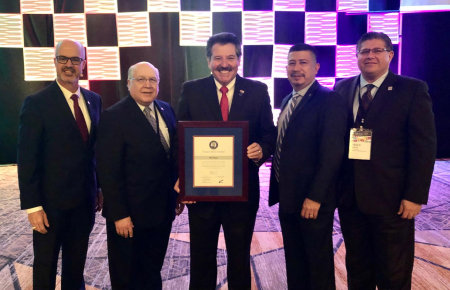
Laredo Mayor Pete Saenz was honored with the Road Hand Award from the Texas Department of Transportation for his advocacy and dedicated work on transportation issues in Texas.
The award highlights Mayor Saenz’ work with TxDOT on behalf of the City of Laredo and other organizations such as Ports-to-Plains, Alliance for I-69, the Border Trade Alliance and others.
Photo: TxDOT Deputy Exec Director Marc Williams, IBC Executive Vice President Gerarld Schwebel, Mayor Pete Saenz, TxDOT Laredo District Engineer David M. Salazar Jr., P.E., and City of Laredo Economic Director Teclo Garcia.
Return to Contents
Ranking Members Highlight Republican Infrastructure Principles
U.S. House Ranking members on the Committee on Transportation and Infrastructure Sam Graves (R-MO) and Rodney Davis (R-IL) highlighted the Republican Infrastructure Principles on January 28, 2020. Click Here for Complete Highlights.
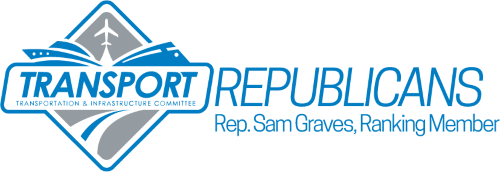
These principals included the following items:
- “Addressing the long-term sustainability of the Highway Trust Fund – continuing the status quo and relying on the fuel taxes as the primary source of funding for the Highway Trust Fund is not a long-term solution to the Trust Fund’s ongoing solvency issues.”
- “Addressing the infrastructure needs of America’s rural communities – 71% of U.S. public road lane-mileage is in rural America. Any increased investment in federal infrastructure funding must ensure that small and rural communities are getting a fair shake and are not being left behind in rebuilding our Nation’s transportation network.”
Return to Contents
Invitation to Terry Wegman Retirement Party
As many of you all know, the Executive Director of Big Spring Economic Development Corporation Terry Wegman will be retiring soon. Please find the attached invitation to his retirement reception. Terry has been a great asset to both Big Spring and the Ports-to-Plains Alliance.
If you are unable to join, you can send cards of well wishes to:
Terry Wegman
215 W 3rd St.
Big Spring, TX 79720
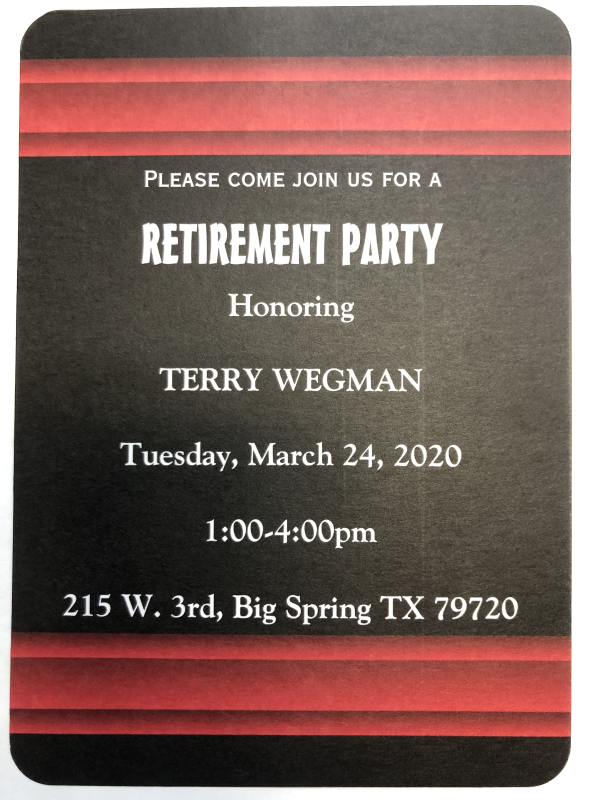
Return to Contents
|